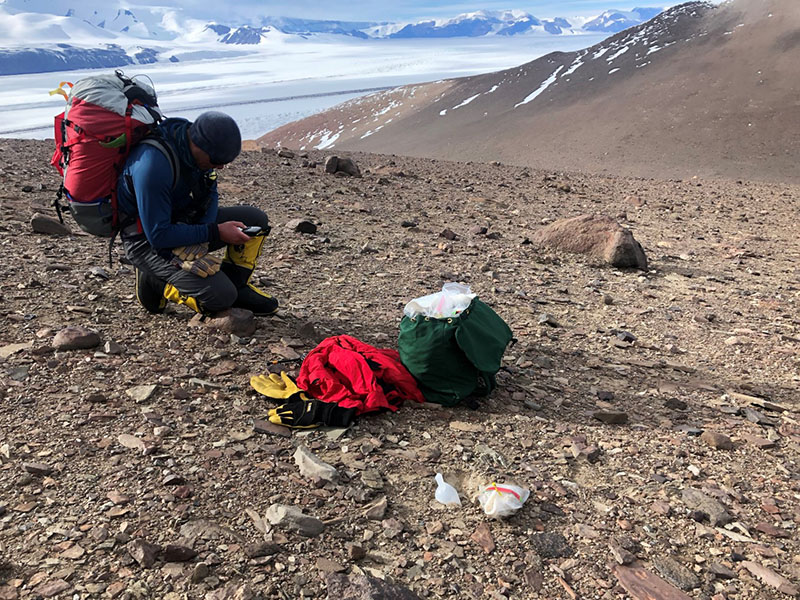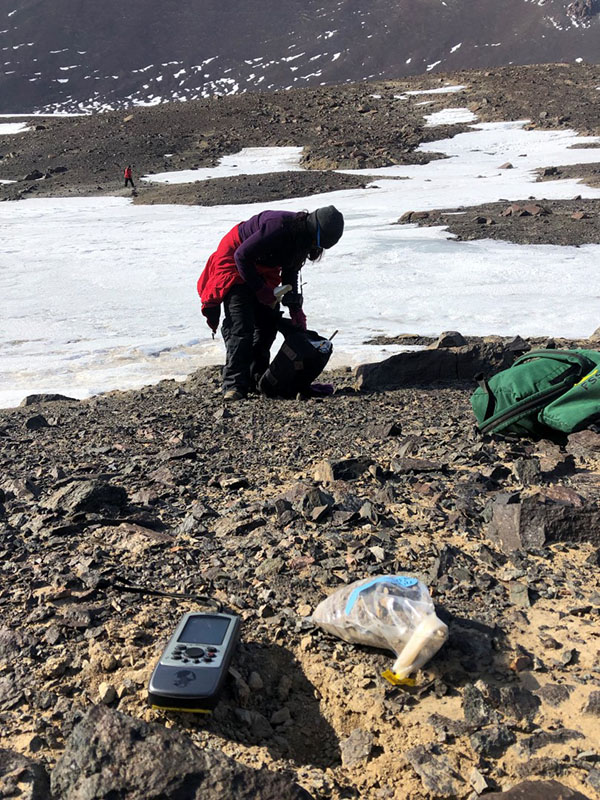An Ecosystem Grows in AntarcticaThe search for life's elusive refuges when the harshest continent was even harsherPosted August 29, 2018
Antarctica's native microorganisms are a hearty bunch, able to eke out a living on the planet’s coldest, highest, driest, windiest and emptiest continent. But the region wasn't always quite as hospitable as it is today. 
Photo Credit: Byron Adams
The team poses for a photo in front of the airplane that brought them to Shackleton field camp. (Left to right) Melisa Diaz, Mountaineer Geoff Schellens, Diana Wall, Noah Fierer, Byron Adams, Marcella Adams and Ian Hogg.
Tens of thousands of years ago the ice in Antarctica covered all but the very highest mountain peaks on the continent. Which leaves lingering questions for scientists about where the microorganisms that populate the continent today came from, and how they survived those harsh conditions. They are questions that a team of researchers working in the remote Transantarctic Mountains sought to answer this past season. And the answers have implications for how life survives and thrives, not just in Antarctica, but in harsh environments worldwide. "What we've been interested in is how animals have managed to persist in Antarctica for a really long period of time," said Ian Hogg, a biologist at Polar Knowledge Canada. "The animals that are found down there are found nowhere else on Earth." It's this uniqueness that has led researchers in recent years to fundamentally reevaluate many preconceived notions. "The existing thoughts up until about 10 or 15 years ago, was that these ice sheets were so extensive that everything, all of the animals that lived there… all of the terrestrial organisms had to have gone extinct and then been recolonized since the last glacial maximum. So since about 14,000 years ago when these ice sheets started to recede," said Byron Adams, a biologist at Brigham Young University and principal investigator on the project. "Then you started to get all of this new real-estate opening up and then it was all colonized from stuff from Australia, New Zealand, South America and Africa." 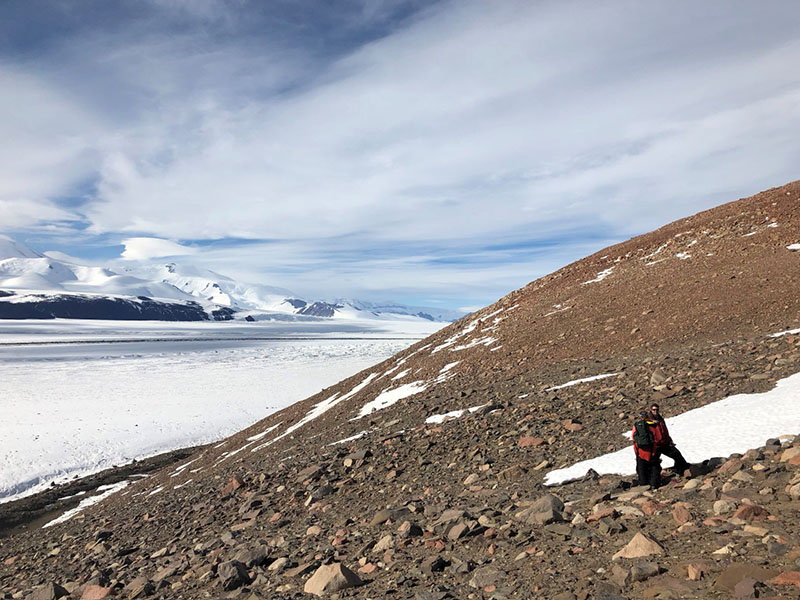
Photo Credit: Byron Adams
Noah Fierer and Diana Wall confer on the side of a mountain in the Transantarctic Mountains.
But as biologists looked more carefully at the microorganisms that live on the continent today, it started becoming more and more apparent that this idea wasn’t holding up. "All of the animals that live here are indigenous only to Antarctica. You didn’t get these incredible new species forming in Antarctica in only 15,000 years," Adams said. "What we’re arguing is that there must have been some stuff that survived the Pleistocene in situ. It survived in Antarctica, when these ice sheets were at their maximum." Adams and his team are looking for insights on where organisms might have taken refuge from these massive glaciers. Microscopic life, such as tardigrades, rotifers and nematodes as well as the tiny invertebrates like springtails, likely evolved on the continent l80 million years ago when the climate was far more temperate. But the whole continent was covered in ice even thicker than today as recently as 18,000 years ago, an era known as the Pleistocene, and it’s not clear where or how these creatures survived during that time. The research is supported by the National Science Foundation, which manages the U.S. Antarctic Program. The team spent two weeks in the Transantarctic Mountains taking soil samples full of microorganisms and scouring the region for any tiny invertebrates that manage to eke out a living in the harsh environment. They're looking for insights into how long ago these creatures evolved and how closely related they are to similar organisms both in Antarctica and around the world. 
Photo Credit: Byron Adams
Melisa Diaz (right) collects a soil sample as mountaineer Geoff Shellens takes a GPS coordinates.
"The idea here is that we extract these animals from the soils and we sequence their DNA, and the DNA tells us something about their past," Adams said. "We can look at the relationships between all of these animals by sequencing their DNA." This way, the team can create a sort of genetic map of when different populations diverged and how long they've been isolated from each other. In effect, the more variance there is between the genetics of two populations are from each other, the longer they've been separated. "Everything mutates, so genes mutate over time, and so the genes that we look at are thought to accumulate these mutations at a sort of a constant rate," Hogg said. "It's termed a 'molecular clock.' So you can then use that molecular clock to see how divergent or how different populations are, and on the basis of how different their sequences are, their genetic information or sequences, you can then estimate how long ago they were last together." The ebb and flow of the glacial sheets is even encoded in these microorganisms' DNA. Geologists think that about 5 million years ago, the ice sheets of West Antarctica collapsed entirely, and there's an echo of that in their genetic code. When the ice disappeared, long-isolated organisms would have been able to move around to different parts of the continent across the newly exposed ground, sharing their genes. Once the glaciers returned, they were unable to interact and once again started mutating in isolation and began to diverge again. "That's what we think is the genetic signal that were seeing," Hogg said. "We're seeing the things that have been isolated for about 5 million years which corresponds to when that ice sheet would have come back in." In addition, the team is also interested in understanding how ecosystems reform after ice sheets recede and formerly uninhabitable land opens up. They collected samples along the slopes of mountains, from areas adjacent to glaciers that likely only receded in the past few hundred years, up the slopes to areas that haven't been covered in ice in millennia, if ever. 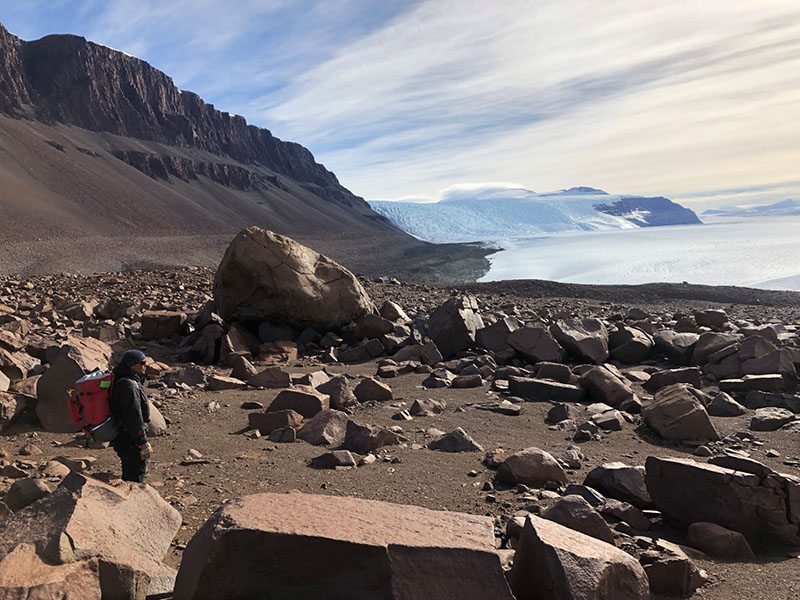
Photo Credit: Byron Adams
Mountaineer Geoff Shellens surveys the landscape on the side of a mountain in the Transantarctic Mountains.
"We would sample across the line of what we thought were new exposed habitats up to the very old ones," said Diana Wall, an ecologist at Colorado State University. "The very old soil habitats, if they've been exposed to all this atmospheric chemistry, nitrogen salts, we would then expect them to be more toxic and it would be harder for the communities to survive, but in these newer ones they would be the soil habitats we would be interested to look at." One of the factors making this search for life's refuges all the more complex is that Antarctic rocks and soil exposed to the atmosphere become toxic to microorganisms over millennia. They absorb nitrogen, which in limited quantities can help plants grow, but as Antarctica is a continent with essentially no native flora, the nitrogen just builds up over time to toxic levels. "The surfaces that have really, really old exposures tend to be pretty bad habitat for these animals, and that's because the soils will accumulate nitrogen from the atmosphere," Adams said. "Here in Antarctica, these soils have never had any grass, or plants or anything to take that nitrogen up, and so that nitrogen accumulates to toxic levels in the soils, you get these really nasty nitrogen salts." Mountaintops that peek out of ice sheets, known as nunataks, would seem like a logical place for organisms to take refuge in soils, but these nitrogen salts would likely prevent them from thriving for long. The team is looking at other possible refuges and adaptations as well, but so far haven’t found a single satisfactory explanation for how life persisted. "There’s another theory that's popular currently in that geothermal habitats might have also provided a refuge as well," Hogg said. "However, where we find a lot of [organisms] now, there hasn't been geothermal activity in quite some time. So while that could be part of the explanation, it's just hard to reconcile it with all of the observations that we're making." In addition to finding where organisms hide out during glaciations, the team is looking to use the different exposure ages up the mountains to understand how organisms return to formerly-ice covered regions and reestablish their ecosystems. "How do these communities assemble?" said Noah Fierer, a microbial biologist at the University of Colorado at Boulder. "We have this gradient of soil age, so how do they start assembling over time." It's an aspect of the research that has implications beyond the harsh slopes of the Transantarctic Mountains and can offer insight into how ecosystems around the world form. Ecosystems like grasslands and jungles are complex and diverse, with countless species of plants, animals and other organisms. Disentangling the roles of each species is nearly impossible. "Because the environment imposes such a harsh constraint on what can live there, the diversity of organisms and the abundance of organisms tend to be very very low," Adams said. "And that's a cool thing for a scientist. That's basically a natural laboratory that has controlled for abundance and diversity. So it makes it the perfect place to study how ecosystems function." What they've seen is the first organisms that reach the virgin soil are usually microorganisms like bacteria and other microbes. After being blown vast distances by the winds, they can take root in the vacant soil and thrive. Once they're abundant enough to sustain them larger microorganisms, tardigrades, rotifers and nematodes follow. They can enter a state known as anhydrobiosis, where they dry out and go dormant for years as they too get blown around the continent. "They essentially go into suspended animation and then when conditions are right, they get liquid water again, then they can come back alive again," Adams said. Larger organisms like arthropods tend to follow, but it's less clear they tend to travel around the continent to new places. They're too big and complex to enter any kind of dormant states, so they have to survive and travel through other means. The team is hoping that by sequencing the genomes of the species they found they can begin to answer some of these questions. At the end of their season, the team made an exciting discovery that illustrates just how confounding the assembly of even a simple ecosystem can be. The teams had been hunting for a particular species of tiny pale, white Collembola that were first discovered on Mount Speed in 1962. Known more commonly as springtails, Collembola are a primitive class of arthropods closely related to insects. 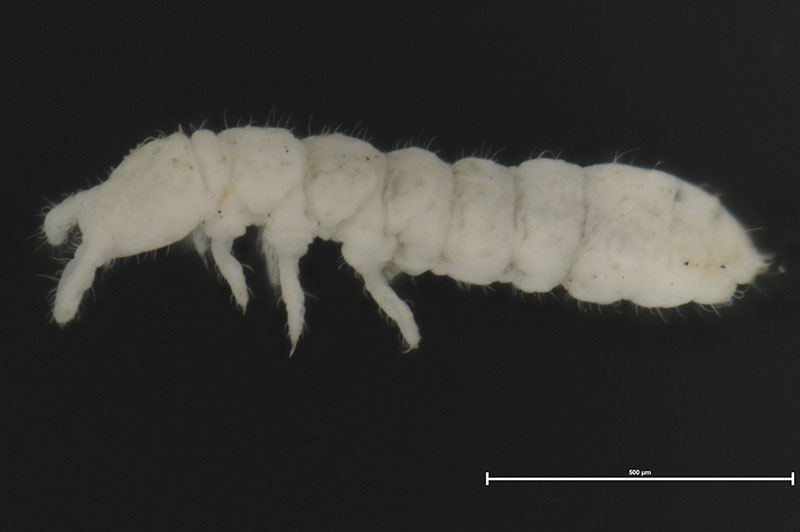
Photo Credit: Gemma Collins, University of Waikato
A close-up image of Tullbergia mediantarctica, the species the team dubbed the "ghost Collembola," collected in the Transantarctic Mountains. The invertebrate's actual size is about 1.2 mm in length, or about the size of a pinhead.
After weeks of searching, the team started to informally call the elusive critters "ghost Collembola" because the team couldn’t seem to find them anywhere. On one of the last days of their season, the team traveled to the same mountain where they were first identified more than 50 years earlier. "When we went back to the exact spot where this person had collected them from in 1962, we found them. So they're located in this one place and in this one place only," Hogg said. "They've managed to persist. They could have possibly been there probably for the last 80 million years, but they're only found in this one spot on this one glacier in the middle of all of Antarctica." This concentration of them is perplexing because on their own Collembola aren't able to disperse very far. They can't fly and likely only walk a few meters over their entire lifetimes. Their best means of dispersing is by hitching a ride on flowing water, but that doesn’t explain how they made it uphill to almost the peak of the mountain. So how they've persisted and when they arrived at Mount Speed is a mystery. "We have looked at the genetic diversity of these, because these guys are pretty simple to look at. And they are all like clones of each other, which sort of suggests a recent founding population made it there and it just really hasn’t expanded beyond Mount Speed yet," Adams said. "How that animal survived the Pleistocene is a complete mystery, I have no explanations for that. We’re sort of wrestling with it." Now back at their respective labs, the team is continuing to analyze more of the DNA of the organisms they returned with. "Our first thing to do is figure out who is there. What's in these samples?" Fierer said. "And then the next step is what are they doing, or what might they be doing, and what unique adaptations do they have to this environment?" NSF-funded research in this story: Byron Adams, Brigham Young University, Award No. 1341736. |



For USAP Participants |
For The Public |
For Researchers and EducatorsContact UsU.S. National Science FoundationOffice of Polar Programs Geosciences Directorate 2415 Eisenhower Avenue, Suite W7100 Alexandria, VA 22314 Sign up for the NSF Office of Polar Programs newsletter and events. Feedback Form |

